Submitted:
09 January 2024
Posted:
09 January 2024
You are already at the latest version
Abstract
Keywords:
1. Introduction
2. Lightning Simulation Model
2.2. Lightning Current Model
2.3. Tower Model
2.4. Insulator Flashover Model
3. VMD Algorithm
4. PE Algorithm
4.1. Introduction to PE
4.2. Selection of PE Parameters
4.3. Symplectic Geometry Mode Decomposition
4.3.1. Phase Space Reconstruction
4.3.2. Symplectic Orthogonal Matrix QR Decomposition
4.3.3. Diagonal Averaging
4.4. PE Improved SGMD
5. Method for Identifying Lightning Faults
5.1. Identification of Short Circuit and Direct Strike Faults
5.2. Identification of Winding Strike and Counterstrike Faults
6. Simulation Validation
7. Conclusion
- (1) In situations where signal decomposition is hindered by challenges such as modal mingling, the utilization of KL-VMD can automatically optimize the decomposition layers and penalty factors. This approach effectively extracts transient characteristic quantities, demonstrating its strong adaptability in fault signal decomposition;
- (2) A criterion is proposed for identifying winding strike, counterstrike, and short circuit faults by analyzing the fault stage traveling wave amplitude, wavefront polarity, rate of change, and modal energy distribution using KL-VMD and PE-SGMD. Following thorough data calculations, the validity and accuracy of this criterion have been confirmed;
- (3) The criterion demonstrates high reliability in accurately distinguishing between short circuit faults and lightning conditions under various lightning current amplitudes, distances, and initial phase angles. It also provides a reference for line fault identification.
Funding
References
- Dong, X.; Zhang, D. Across the Tianshan mountains of 750 kV transmission line lightning risk assessment. Electr. Power Sci. Eng. 2015, 31, 66–71. [Google Scholar]
- Zhang, D.; Dong, X.; Tao, F.; Wang, S. Research on reduction of the monsoon influence on the transmission line shielding failure. Insul. Surge Arresters 2014, 259, 57–61. [Google Scholar]
- Zhao, C.; Chen, J.; Gu, S.; Ruan, J.; Li, X.; Tong, X.; Hu, W. Research on differentiated lightning protection comprehensive management for the 500-kV power network in the area near the three gorges project. IEEE transactions on power delivery 2011, 27, 337–352. [Google Scholar]
- Jiang, K.; Du, L.; Chen, H.; Yang, F.; Wang, Y. Non-contact measurement and polarity discrimination-based identification method for direct lightning strokes. Energies 2019, 596, 263. [Google Scholar] [CrossRef]
- Zou, G.; Gao, H.; Zhu, F.; Wang, H. Integral identification method of lightning stroke and fault for transmission line. Power Syst. Prot. Control 2012, 40, 43–48. [Google Scholar]
- Shu, H.; Wang, Y.; Cheng, C.; Sun, S. Analysis of electromagnetic transient and fault detection on ±800 kV UHVDC transmission lines under lightning stroke. Proc. CSEE 2008, 28, 93–100. [Google Scholar]
- Sima, W.; Xie, B.; Yang, Q.; Wang, J. Identification of lightning over-voltage about UHV transmission line. High Volt. Eng. 2010, 36, 306–312. [Google Scholar]
- Guo, N.; Qin, J. Locating method of short-circuit point for transmission lines under lightning stroke fault. Autom. Electr. Power Syst. 2009, 33, 74–77. [Google Scholar]
- Zhong, H.; Chen, J.; Fu, Q.; Hua, M. Lightning strike identification algorithm of an all-parallel auto-transformer traction power supply system based on morphological fractal theory. IEEE Trans. Power Deliv. 2023, 38, 2119–2132. [Google Scholar] [CrossRef]
- Si, D.; Shu, H.; Chen, X.; Yu, J. Study on characteristics and identification of transients on transmission lines caused by lightning stroke. Proc. CSEE 2005, 25, 64–69. [Google Scholar]
- Gao, Y.; Zhu, Y.; Yan, H.; Yan, H. Identification of lightning strike and short-circuit fault based on wavelet energy spectrum and transient waveform characteristics. Mechatron. Ind. Inform. 2014, 596, 713–718. [Google Scholar] [CrossRef]
- Chen, Z.; Pei, H.; Teng, C. Identification of transmission line lightning based on HHT. Int. J. Smart Home 2016, 10, 201–212. [Google Scholar]
- Zhao, H.; Wang, X.; Gao, C. Traveling wave fault location method for high voltage transmission lines based on FIMD and Hilbert transform. Electr. Meas. Instrum. 2020, 57, 77–82. [Google Scholar]
- Han, Z.; Rao, S.; Jiang, Y.; Wang, S.; Liu, J.; Lu, Y. Energy ratio function-based traveling-wave fault location for transmission lines. Power Syst. Technol. 2011, 35, 216–220. [Google Scholar]
- Liu, J.; Su, Y.; Deng, R.; Sun, F. Performance degradation assessment of rolling bearing based on KL-VMD and comprehensive characteristic indexes. J. Electron. Meas. Instrum. 2022, 36, 78–88. [Google Scholar]
- Xi, Y.; Cui, Y.; Tang, X.; Li, Z.; Zeng, X. Fault location of lightning strikes using residual analysis based on an adaptive kalman filter. IEEE Access 2019, 7, 88126–88137. [Google Scholar] [CrossRef]
- Gu, Y.; Song, G.; Guo, A.; Tao, R.; Liu, Y. A lightning recognition method for DC line travling-wave protection of HVDC. Proc. CSEE 2018, 38, 3837–3845+4024. [Google Scholar]
- Long, Y.; Yao, C.; Mi, Y.; Hu, D.; Yang, N. Liao, Y Identification of direct lightning strike faults based on mahalanobis distance and S-transform IEEE Trans. Dielectr. Electr. Insul. 2015, 22, 2019–2030. [Google Scholar] [CrossRef]
- Song, X.; Gao, Y.; Ding, G.; Yan, H. Lightning strike interference and fault identification of transmission system. Insul. Surge Arresters, 2021; 299, 96–102+110. [Google Scholar]
- Deng, L.; Zhang, A.; Zhao, R. Intelligent identification of incipient rolling bearing faults based on VMD and PCA-SVM. Adv. Mech. Eng. 2022, 14, 1–18. [Google Scholar] [CrossRef]
- Li, J.; Zhu, X.; Guo, J. Bridge modal identification based on successive variational mode decomposition using a moving test vehicle. Adv. Struct. Eng. 2022, 25, 2284–2300. [Google Scholar] [CrossRef]
- Harmouche, J.; Delpha, C.; Diallo, D. Incipient fault amplitude estimation using KL divergence with a probabilistic approach. Signal Process. 2016, 120, 1–7. [Google Scholar] [CrossRef]
- Bandt, C.; Pompe, B. Permutation entropy: a natural complexity measure for time series. Physical review letters 2002, 88, 174102. [Google Scholar] [CrossRef]
- Li, X.; Ouyang, G.; Richards, D.A. Predictability analysis of absence seizures with permutation entropy. Epilepsy Res. 2007, 77, 70–74. [Google Scholar] [CrossRef] [PubMed]
- Ricci, L.; Politi, A. Permutation entropy of weakly noise-affected signals. Entropy 2022, 24, 54. [Google Scholar] [CrossRef]
- Ouyang, G.; Li, J.; Liu, X.; Li, X. Dynamic characteristics of absence EEG recordings with multiscale permutation entropy analysis. Epilepsy Res. 2013, 104, 246–252. [Google Scholar] [CrossRef]
- Zheng, Z.; Xin, G. Fault feature extraction of hydraulic pumps based on symplectic geometry mode decomposition and power spectral entropy. Entropy 2019, 21, 476. [Google Scholar] [CrossRef] [PubMed]
- Pan, H.; Yang, Y.; Li, X.; Zheng, J.; Cheng, J. Symplectic geometry mode decomposition and its application to rotating machinery compound fault diagnosis. Mech. Syst. Signal Process. 2019, 114, 189–211. [Google Scholar] [CrossRef]
- Dai, J.; Liu, Y.; Jiang, W.; Liu, Z.; Sheng, G.; Yan, Y.; Jiang, X. Identification of back striking and shielding failure on transmission line based on time domain characteristics of traveling wave. Trans. China Electrotech. Soc. 2016, 31, 242–250. [Google Scholar]

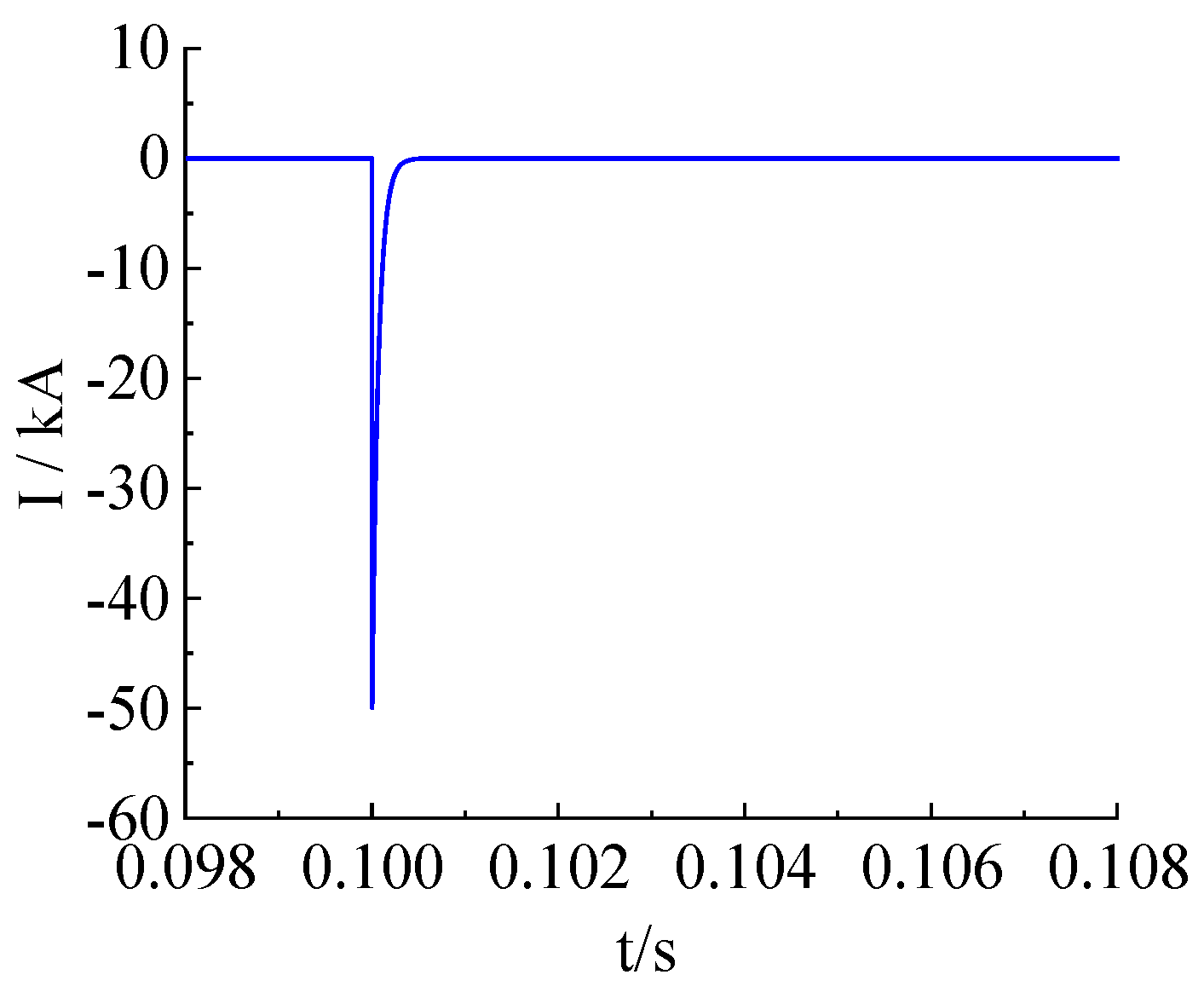
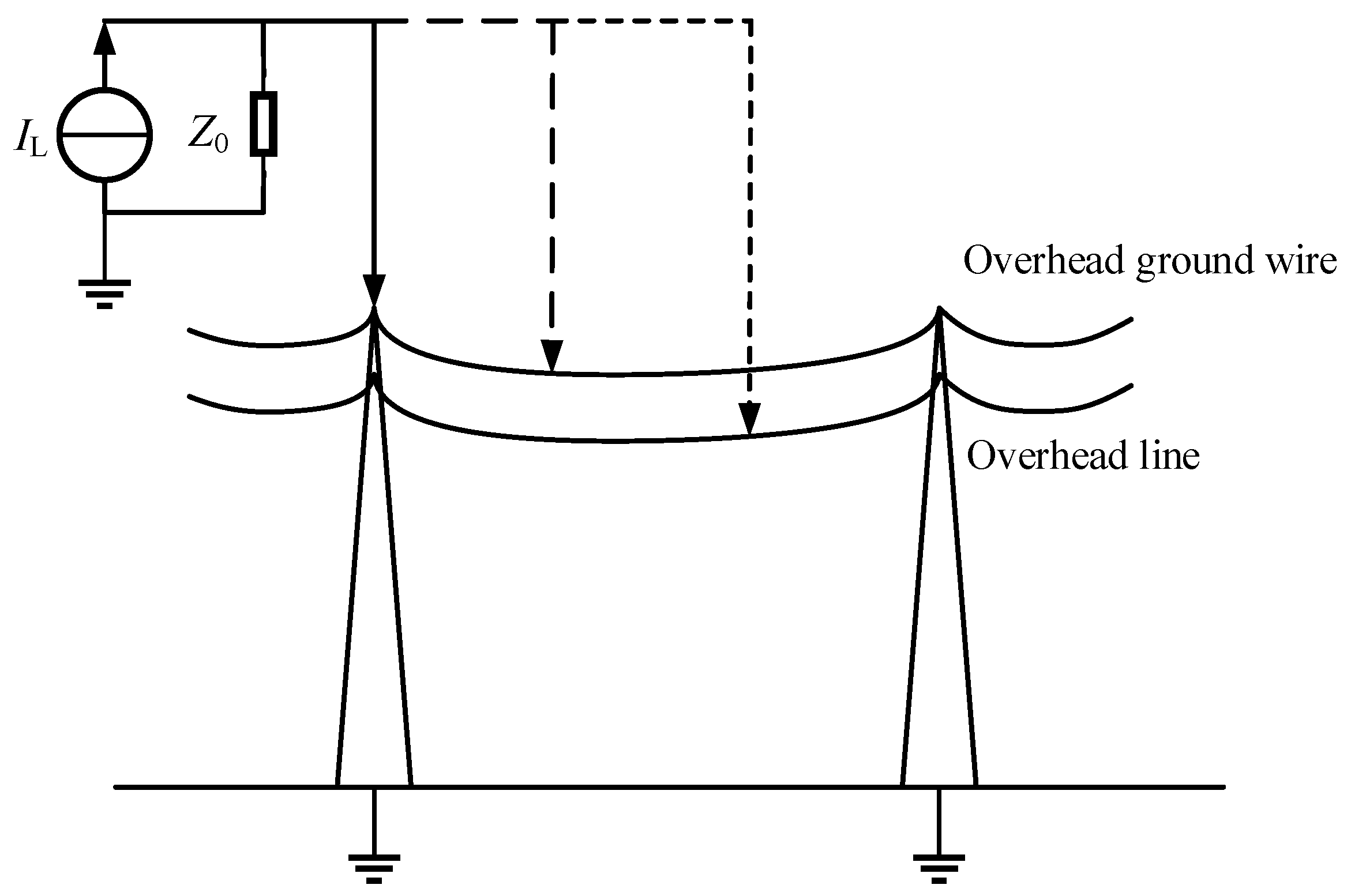
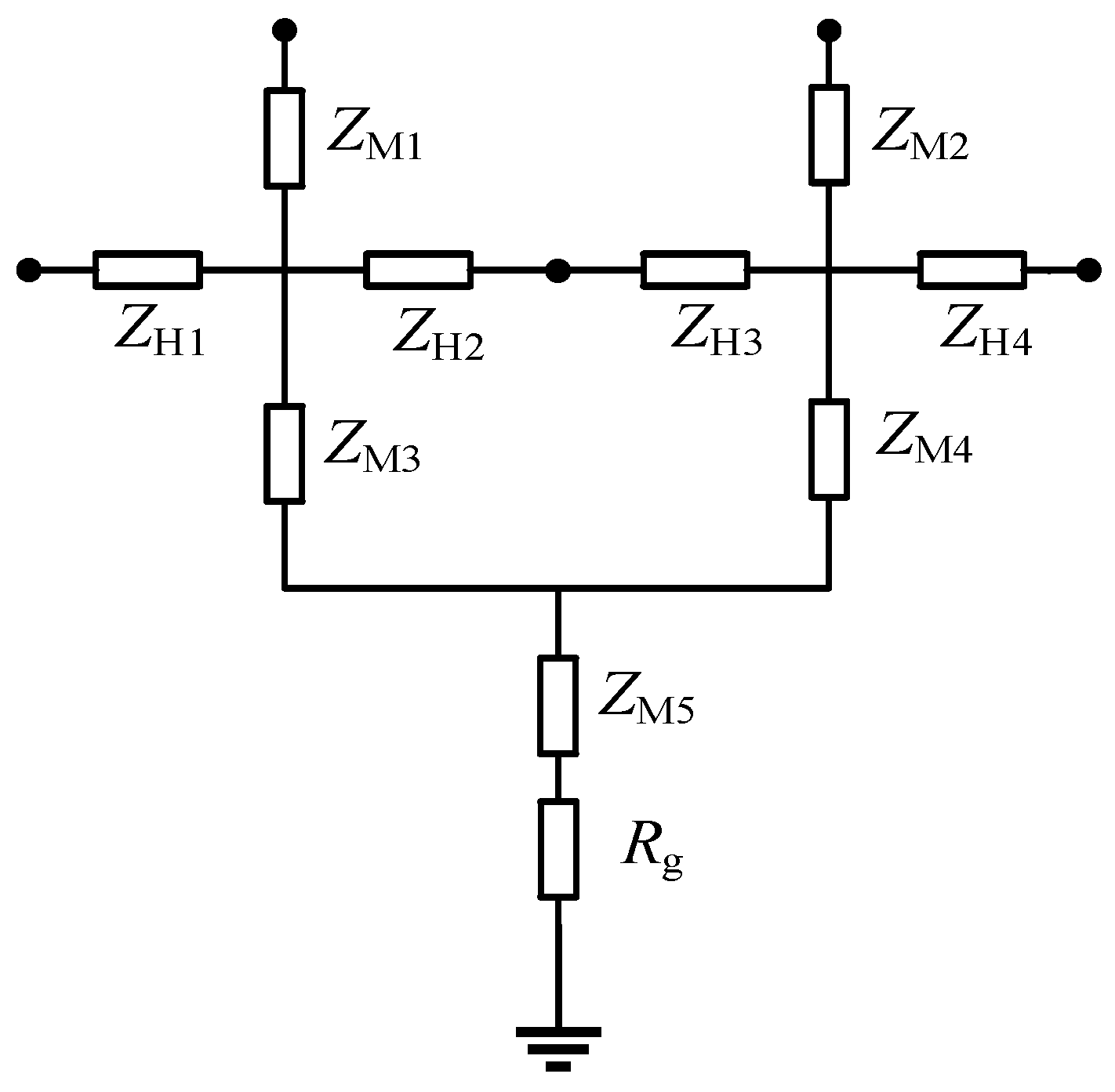
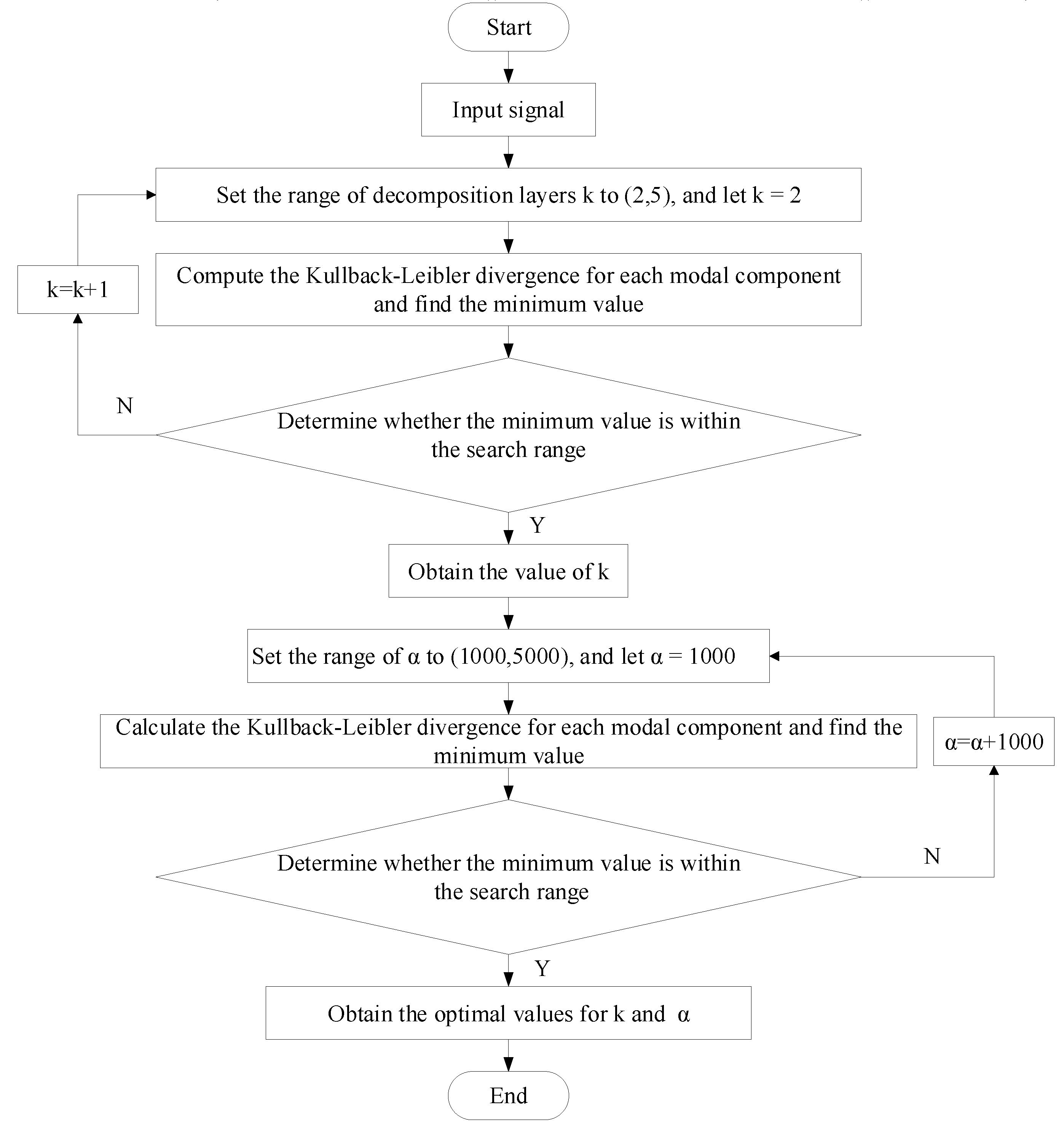
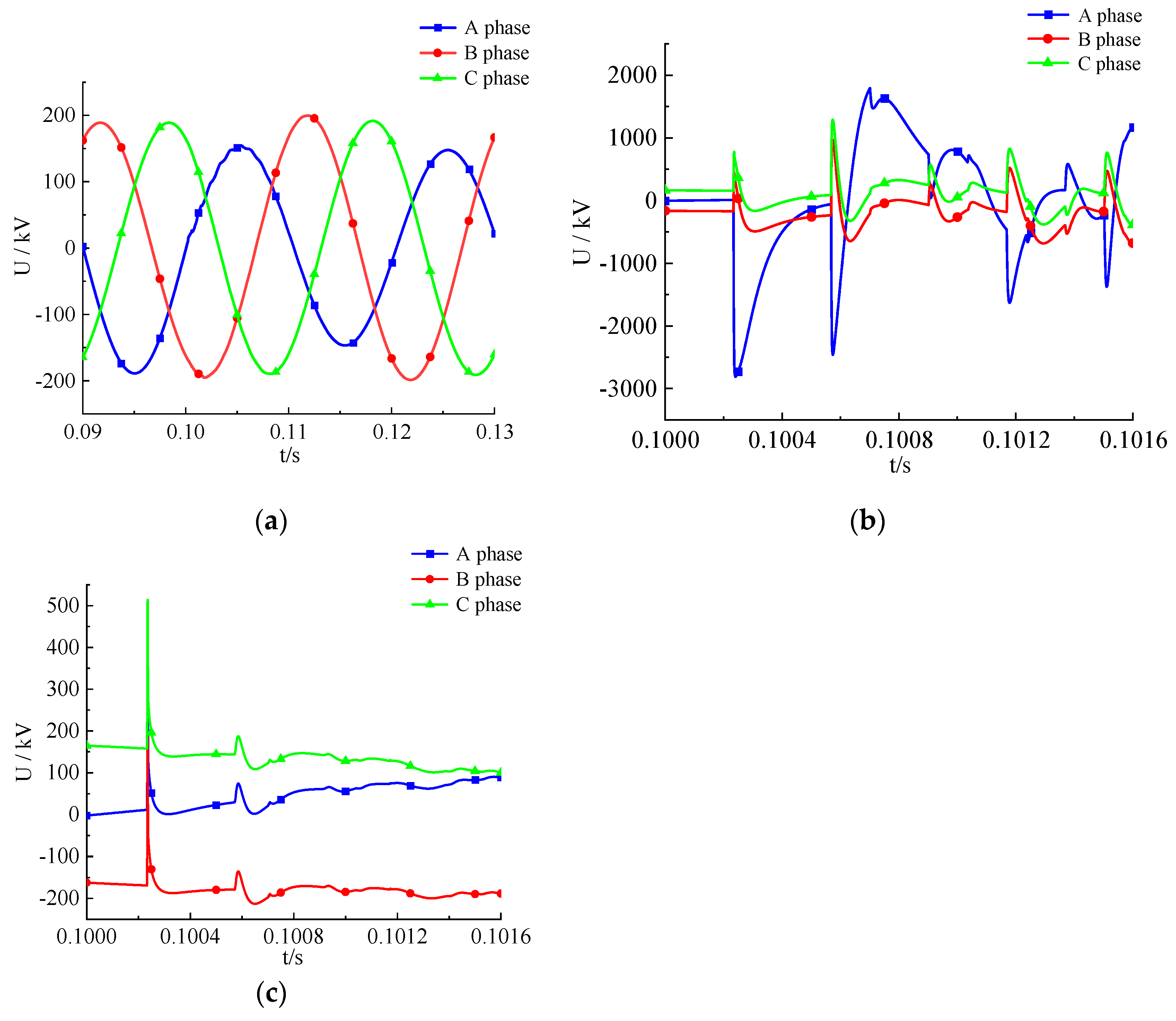
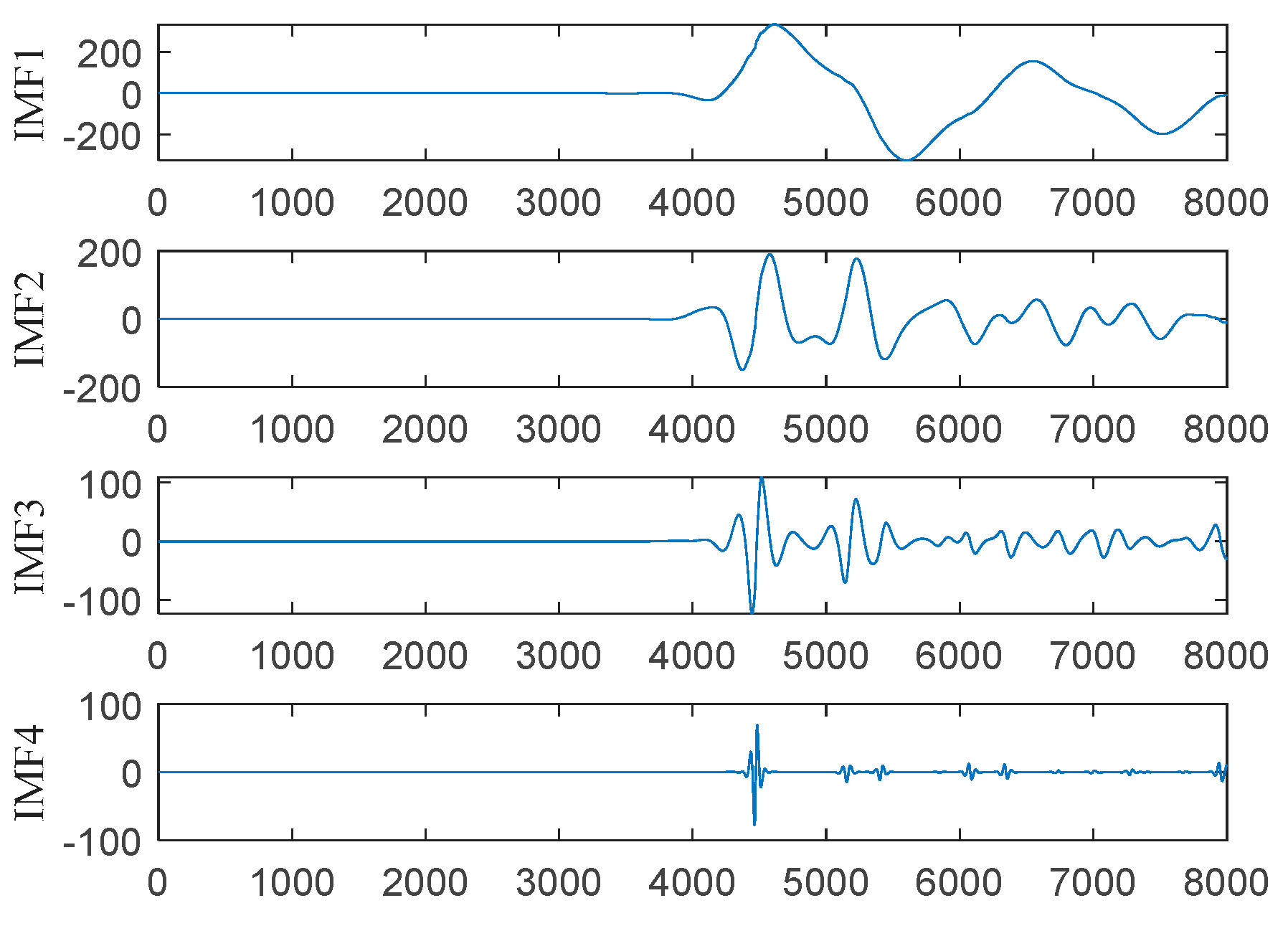
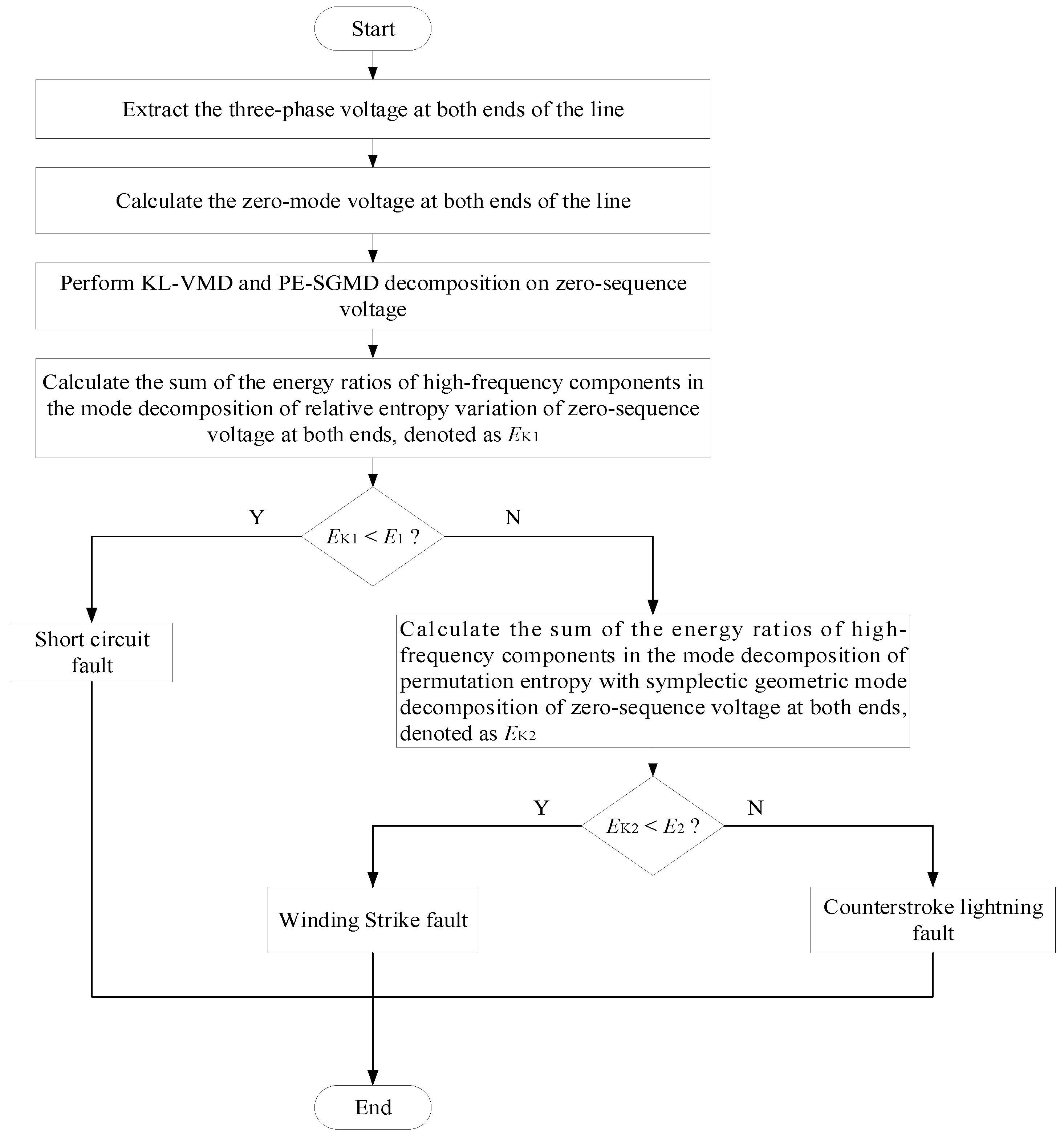
| Fault Type | PC/km | PD/km | EK1 |
|---|---|---|---|
| Short Circuit Fault | 30 | 126 | 1.3326e-05 |
| Short Circuit Fault | 40 | 116 | 1.3516e-05 |
| Short Circuit Fault | 50 | 106 | 1.4201e-05 |
| Short Circuit Fault | 60 | 96 | 1.5051e-05 |
| Winding Strike | 30 | 126 | 0.0159 |
| Winding Strike | 40 | 116 | 0.0356 |
| Winding Strike | 50 | 106 | 0.5490 |
| Winding Strike | 60 | 96 | 0.2999 |
| Counterstrike | 30 | 126 | 0.0664 |
| Counterstrike | 40 | 116 | 0.0352 |
| Counterstrike | 50 | 106 | 0.0318 |
| Counterstrike | 60 | 96 | 0.0343 |
| Fault Type | PC/km | PD/km | Ek2 |
|---|---|---|---|
| Winding Strike | 30 | 126 | 0.0026 |
| Winding Strike | 40 | 116 | 0.0043 |
| Winding Strike | 50 | 106 | 0.0033 |
| Winding Strike | 60 | 96 | 0.0029 |
| Winding Strike | 70 | 86 | 0.0068 |
| Counterstrike | 30 | 126 | 0.1930 |
| Counterstrike | 40 | 116 | 0.1724 |
| Counterstrike | 50 | 106 | 0.1901 |
| Counterstrike | 60 | 96 | 0.1923 |
| Counterstrike | 70 | 86 | 0.1641 |
| Distance/km | 30km | 50km | 70km | ||||||
|---|---|---|---|---|---|---|---|---|---|
| EK1 | EK2 | Result | EK1 | EK2 | Result | EK1 | EK2 | Result | |
| Phase A ground short circuit, Rg=30Ω,θ=90° | 1.3326e-05 | — | Short Circuit | 1.4201e-05 | — | Short Circuit |
2.0681e-05 | — | Short Circuit |
| Phase A ground short circuit, Rg=50Ω,θ=0° | 1.6745e-05 | — | Short Circuit | 1.8363e-05 | — | Short Circuit |
2.7329e-05 | — | Short Circuit |
| Phase AB ground short circuit, Rg=30Ω,θ=90° | 2.9690e-05 | — | Short Circuit | 2.6474e-05 | — | Short Circuit |
3.0331e-05 | — | Short Circuit |
| Phase AB ground short circuit, Rg=50Ω,θ=90° | 3.1702e-05 | — | Short Circuit | 2.8562e-05 | — | Short Circuit |
3.0805e-05 | — | Short Circuit |
| Winding Strike, Imax=30 kA, θ=0°,1.2/50 μs |
0.3145 | 0.0035 | Winding Strike | 0.5705 | 0.0088 | Winding Strike | 0.5166 | 0.0088 | Winding Strike |
| Winding Strike, Imax=40 kA, θ=0°,2.6/50 μs |
0.3168 | 0.0029 | Winding Strike | 0.5781 | 0.0087 | Winding Strike | 0.5196 | 0.0091 | Winding Strike |
| Winding Strike, Imax=50 kA, θ=90°,1.2/50 μs |
0.0159 | 0.0026 | Winding Strike | 0.5492 | 0.0033 | Winding Strike | 0.2793 | 0.0068 | Winding Strike |
| Winding Strike, Imax=60 kA, θ=90°,2.6/50 μs |
0.0165 | 0.0026 | Winding Strike | 0.5526 | 0.0039 | Winding Strike | 0.2817 | 0.0063 | Winding Strike |
| Counterstrike, Imax=50 kA, θ=90°,1.2/50 μs |
0.0664 | 0.1914 | Counterstrike | 0.0318 | 0.1896 | Counterstrike | 0.0324 | 0.1636 | Counterstrike |
| Counterstrike, Imax=60 kA, θ=90°,2.6/50 μs |
0.0701 | 0.1707 | Counterstrike | 0.0318 | 0.1557 | Counterstrike | 0.0328 | 0.1443 | Counterstrike |
| Counterstrike, Imax=70 kA, θ=0°,1.2/50 μs |
0.0783 | 0.1930 | Counterstrike | 0.0622 | 0.1901 | Counterstrike | 0.0404 | 0.1641 | Counterstrike |
| Counterstrike, Imax=80 kA, θ=0°,2.6/50 μs |
0.0697 | 0.1688 | Counterstrike | 0.0669 | 0.1562 | Counterstrike | 0.0540 | 0.1447 | Counterstrike |
Disclaimer/Publisher’s Note: The statements, opinions and data contained in all publications are solely those of the individual author(s) and contributor(s) and not of MDPI and/or the editor(s). MDPI and/or the editor(s) disclaim responsibility for any injury to people or property resulting from any ideas, methods, instructions or products referred to in the content. |
© 2024 by the authors. Licensee MDPI, Basel, Switzerland. This article is an open access article distributed under the terms and conditions of the Creative Commons Attribution (CC BY) license (http://creativecommons.org/licenses/by/4.0/).




